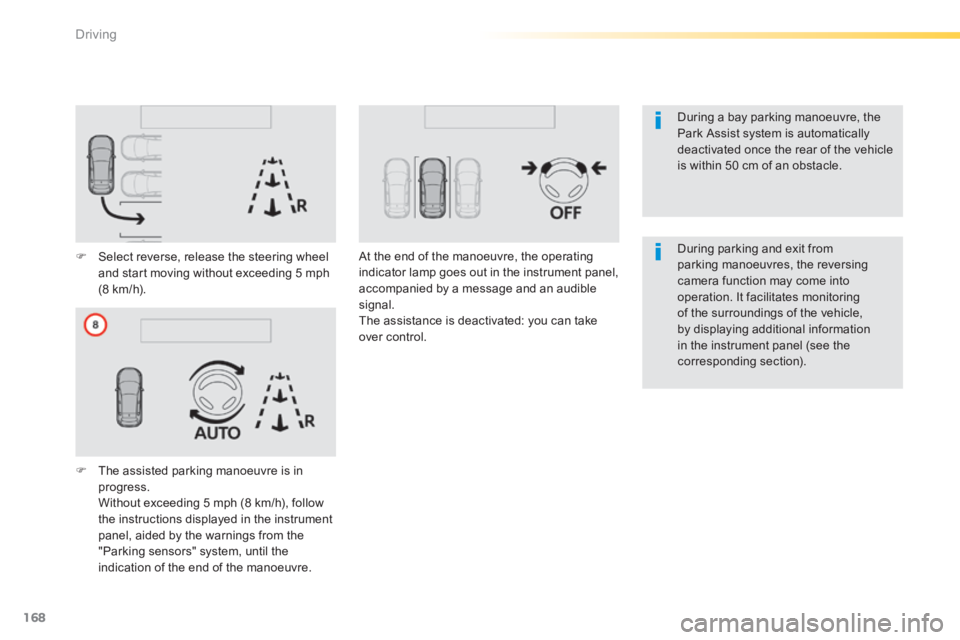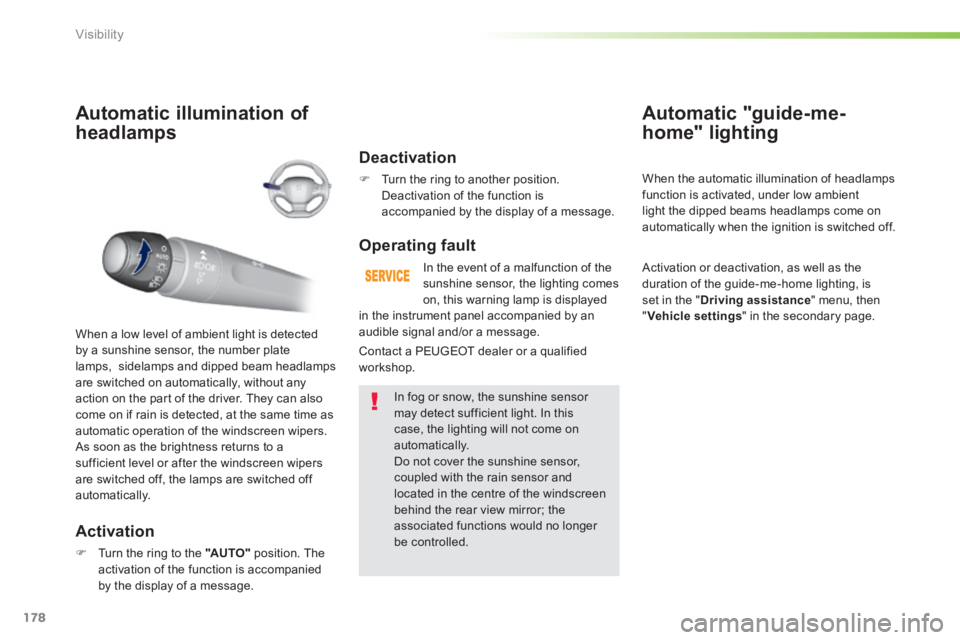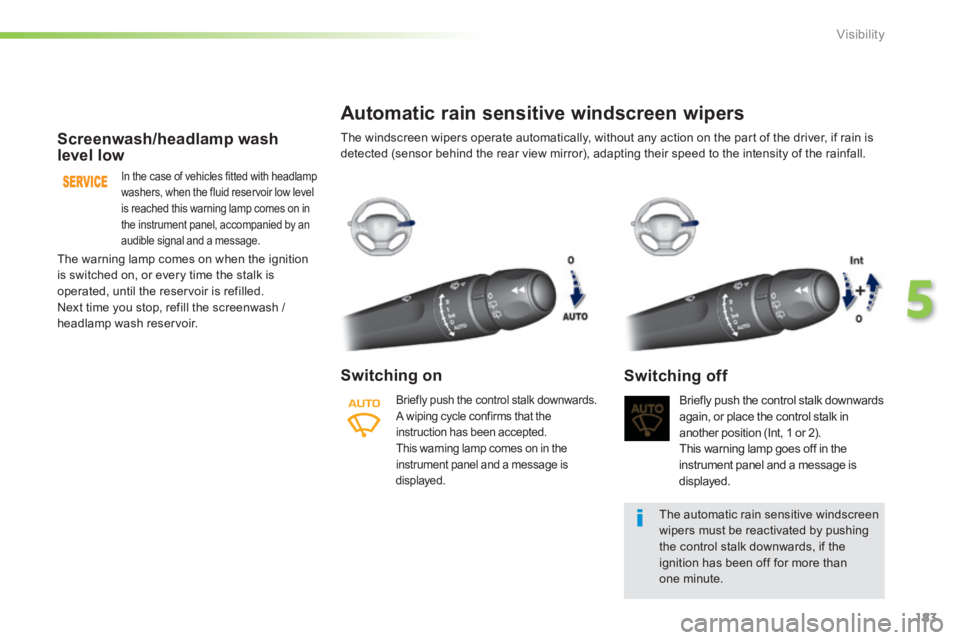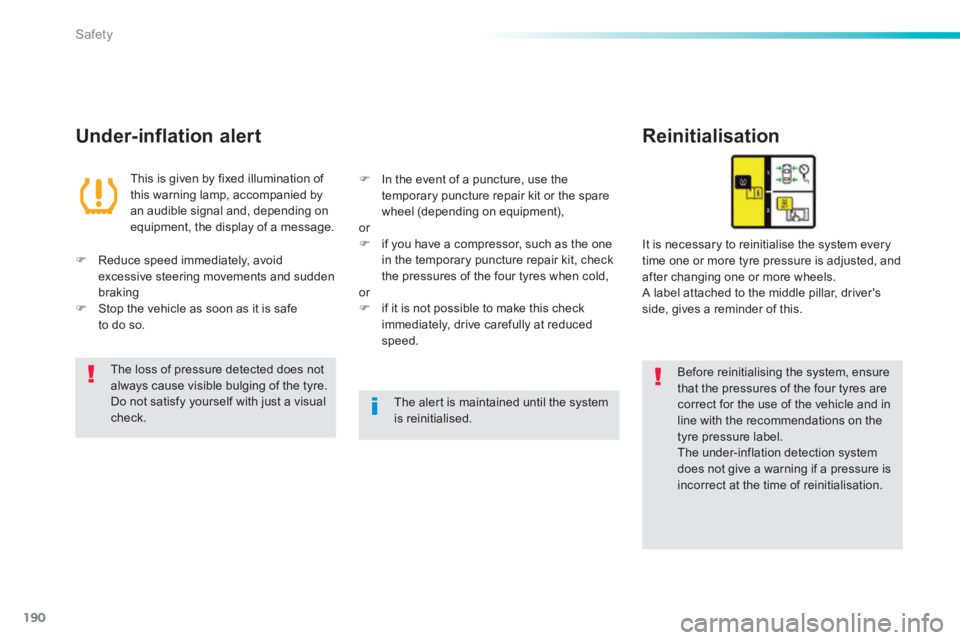Page 170 of 400

168
Driving
308_EN_CHAP04_CONDUITE_ED02-2013
During a bay parking manoeuvre, the Park Assist system is automatically deactivated once the rear of the vehicle is within 50 cm of an obstacle.
Select reverse, release the steering wheel and start moving without exceeding 5 mph (8 km/h).
The assisted parking manoeuvre is in progress. Without exceeding 5 mph (8 km/h), follow the instructions displayed in the instrument
panel, aided by the warnings from the "Parking sensors" system, until the indication of the end of the manoeuvre.
At the end of the manoeuvre, the operating indicator lamp goes out in the instrument panel, accompanied by a message and an audible signal. The assistance is deactivated: you can take over control.
During parking and exit from parking manoeuvres, the reversing camera function may come into operation. It facilitates monitoring of the surroundings of the vehicle, by displaying additional information in the instrument panel (see the corresponding section).
Page 171 of 400

169
4
Driving
308_EN_CHAP04_CONDUITE_ED02-2013
The system is deactivated automatically: - on switching off the ignition, - if the engine stalls, - if no manoeuvre is started within 5 minutes of selection of the type of manoeuvre, - after a prolonged stop of the vehicle during a manoeuvre, - if the road wheel anti-slip regulation (ASR) is triggered, - if the speed of the vehicle exceeds the stated limit, - when the driver interrupts movement of the steering wheel, - if the driver presses the Park Assist control, - after 4 manoeuvre cycles, - on opening the driver's door, - if one of the front wheels encounters an obstacle.
The operation indicator lamp goes off in the instrument panel and a message is displayed accompanied by an audible signal. The driver should then take back control of the vehicle's steering.
Deactivation
If the system is deactivated during a manoeuvre, the drive should reactivate it manually to repeat the measurement.
The system is switched off automatically: - when towing a trailer, - if the driver's door is opened, - if the speed of the vehicle is above 42 mph (70 km/h). To switch the system of for a prolonged period, contact a PEUGEOT dealer or a qualified workshop.
In the event of a fault with the system, this warning lamp is displayed in the instrument panel and a message appears, accompanied by an audible signal.
Operating faults
In the event of a fault with the power steering, this warning lamp comes on in the instrument panel accompanied by an alert message.
Contact a PEUGEOT dealer or a qualified workshop.
Switching off
If the lateral distance between your vehicle and the space is too great, the system may not be able to measure the space. Anything projecting beyond the envelope of the vehicle (long or wide load) is not taken into account by the Park Assist system during a manoeuvre.
In bad weather or in winter, ensure that the sensors are not covered by road dirt, ice or snow. In the event of a fault, have the system checked by a PEUGEOT dealer or a qualified workshop.
The indicator lamp for the function flashes for a few seconds. If the fault occurs during the use of the system, the indicator lamp goes off.
Page 180 of 400

178
Visibility
308_EN_CHAP05_VISIBILITE_ED02-2013
Automatic illumination of
headlamps
Activation
Turn the ring to the "AUTO" position. The activation of the function is accompanied by the display of a message.
When a low level of ambient light is detected by a sunshine sensor, the number plate lamps, sidelamps and dipped beam headlamps are switched on automatically, without any action on the part of the driver. They can also come on if rain is detected, at the same time as
automatic operation of the windscreen wipers. As soon as the brightness returns to a sufficient level or after the windscreen wipers are switched off, the lamps are switched off automatically.
Deactivation
Turn the ring to another position. Deactivation of the function is accompanied by the display of a message.
Operating fault
In the event of a malfunction of the sunshine sensor, the lighting comes on, this warning lamp is displayed
In fog or snow, the sunshine sensor may detect sufficient light. In this case, the lighting will not come on automatically. Do not cover the sunshine sensor, coupled with the rain sensor and located in the centre of the windscreen behind the rear view mirror; the associated functions would no longer be controlled.
Automatic "guide-me-
home" lighting
When the automatic illumination of headlamps function is activated, under low ambient light the dipped beams headlamps come on
automatically when the ignition is switched off.
Activation or deactivation, as well as the duration of the guide-me-home lighting, is set in the " Driving assistance " menu, then " Vehicle settings " in the secondary page.
Contact a PEUGEOT dealer or a qualified workshop.
in the instrument panel accompanied by an audible signal and/or a message.
Page 182 of 400

180
Visibility
308_EN_CHAP05_VISIBILITE_ED02-2013
Halogen headlamps "Full LED"
headlamps
Manual adjustment
If a fault occurs, this warning lamp is displayed in the instrument panel, accompanied by an audible signal and a message in the instrument panel screen.
In order to avoid causing a nuisance to other road users, this system corrects the height of the "full LED" headlamps beam automatically, in relation to the load in the vehicle.
If a fault occurs, do not touch the "full LED" bulbs. Contact a PEUGEOT dealer or a qualified workshop.
The initial setting is position "0" .
The system then places your headlamps in the lowest position.
Travelling abroad
If using your vehicle in a country that drives on the other side of the road, the headlamps must be adjusted to avoid dazzling on-coming drivers. Contact a PEUGEOT dealer or a qualified workshop.
To avoid causing a nuisance to other road users, the beams of the halogen headlamps should be adjusted according to the load in the vehicle. 0 Driver or driver + front passenger. - Driver + front passenger + rear passengers. 1 5 people. - 5 people + a load in the boot. 2 Driver + a load in the boot.
Automatic adjustment
Page 185 of 400

183
5
Visibility
308_EN_CHAP05_VISIBILITE_ED02-2013
Screenwash/headlamp wash level low
In the case of vehicles fitted with headlamp washers, when the fluid reservoir low level is reached this warning lamp comes on in
the instrument panel, accompanied by an audible signal and a message.
Automatic rain sensitive windscreen wipers
Switching on
Briefly push the control stalk downwards. A wiping cycle confirms that the instruction has been accepted. This warning lamp comes on in the instrument panel and a message is displayed.
Briefly push the control stalk downwards again, or place the control stalk in
another position (Int, 1 or 2). This warning lamp goes off in the instrument panel and a message is displayed.
Switching off
The automatic rain sensitive windscreen wipers must be reactivated by pushing the control stalk downwards, if the ignition has been off for more than one minute.
The warning lamp comes on when the ignition is switched on, or every time the stalk is operated, until the reservoir is refilled. Next time you stop, refill the screenwash / headlamp wash reservoir.
The windscreen wipers operate automatically, without any action on the part of the driver, if rain is detected (sensor behind the rear view mirror), adapting their speed to the intensity of the rainfall.
Page 189 of 400
187
6
Safety
308_EN_CHAP06_SECURITE_ED02-2013
Automatic operation of
hazard warning lamps
Direction indicators
Left: lower the lighting stalk passing the point of resistance. Right: raise the lighting stalk passing the point of resistance.
Three fl ashes of the direction indicators
Hazard warning lamps
A visual warning by means of the direction indicators to alert other road users to a vehicle breakdown, towing or accident. Press this button, the direction indicators flash. They can operate with the ignition off.
Press briefly upwards or downwards, without going beyond the point of resistance; the direction indicators will flash 3 times.
When braking in an emergency, depending on the rate of deceleration, as well as when the ABS regulation is invoked or in the event of an impact, the hazard warning lamps come on automatically. They switch off automatically the first time you accelerate. You can also switch them off by pressing the button.
Page 190 of 400
188
Safety
308_EN_CHAP06_SECURITE_ED02-2013
Horn
Press the central part of the multifunction steering wheel.
Audible warning system to alert other road users to an imminent danger.
Use the horn moderately and only in the following circumstances: - immediate danger, - overtaking a cyclist or pedestrian, - approaching a location lacking visibility.
Emergency or
assistance call
This system allows you to make an emergency or assistance call to the emergency services or to the dedicated PEUGEOT service.
For more information on the use of this function, refer to the "Audio equipment and telematics" section.
Page 192 of 400

190
Safety
308_EN_CHAP06_SECURITE_ED02-2013
Under-inflation alert Reinitialisation
Before reinitialising the system, ensure that the pressures of the four tyres are correct for the use of the vehicle and in line with the recommendations on the tyre pressure label. The under-inflation detection system does not give a warning if a pressure is incorrect at the time of reinitialisation.
This is given by fixed illumination of this warning lamp, accompanied by an audible signal and, depending on
equipment, the display of a message.
It is necessary to reinitialise the system every time one or more tyre pressure is adjusted, and after changing one or more wheels. A label attached to the middle pillar, driver's side, gives a reminder of this.
Reduce speed immediately, avoid excessive steering movements and sudden braking Stop the vehicle as soon as it is safe to do so.
In the event of a puncture, use the temporary puncture repair kit or the spare wheel (depending on equipment), or if you have a compressor, such as the one in the temporary puncture repair kit, check the pressures of the four tyres when cold, or if it is not possible to make this check immediately, drive carefully at reduced speed.
The loss of pressure detected does not always cause visible bulging of the tyre. Do not satisfy yourself with just a visual check. The alert is maintained until the system is reinitialised.